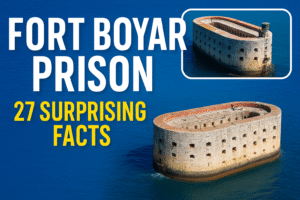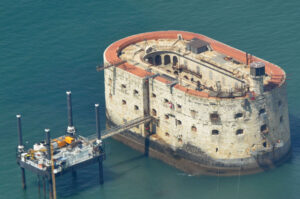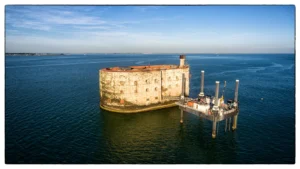Fort Boyard Prison: Surprising Facts, Rich History & Easy Travel Tips (Ultimate Guide)
What Is fort boyard prison?
If you’ve ever seen that mysterious oval fort rising from the Atlantic between Île-d’Aix and Île d’Oléron, you’ve already met fort boyard prison.
Built on a shallow sandbank in the Pertuis d’Antioche straits (Charente-Maritime, France), it began as a 19th-century sea fortress meant to shield the Rochefort naval arsenal.
Soon after, it briefly served as a military prison, then slipped into abandonment—before a hit TV show made it world-famous. Today, you can’t tour the interior, but you can circle it by boat and admire a one-of-a-kind engineering feat.
Its classic stadium-like outline measures about 68 m long by 31 m wide, with walls roughly 20 m high—numbers that hint at the sheer effort required to anchor a fort in moving water and shifting sand.

Quick Facts at a Glance
-
Where: Between Île-d’Aix and Île d’Oléron, Charente-Maritime (Nouvelle-Aquitaine), France.
-
When built: Start 1801; completion 1857; active to 1913.
-
Shape & size: Stadium/oval; ~68 × 31 m; walls ~20 m tall.
-
Original purpose: Protect the Rochefort arsenal and the Charente estuary.
-
Later use: Military prison after 1871; later abandoned.
-
Fame today: Filming location for the game show Fort Boyard since 1990.
Origins: From Idea to Obsession
In the 1600s, cannons on Île-d’Aix and Île d’Oléron couldn’t cover the gap between their fields of fire. That “blind spot” tempted enemy ships. A fort right on Boyard Bank would close the gap—but the site was basically a sandbar, swept by tide and wind. Engineers sketched plans during the reign of Louis XIV, paused them, then revived them again after an English raid on Île-d’Aix in 1757. The idea kept returning because the need was real, yet the location was punishing.
Vauban’s Famous Warning
France’s star military engineer Sébastien Le Prestre de Vauban reportedly warned the king that building there would be like “seizing the moon with your teeth.” It’s a vivid way of saying: the sea wins. His skepticism wasn’t drama—he knew the Atlantic’s moods, the sediment shifts, and how much stone it would take to stand still on a moving floor. That said, strategy often outlives engineering caution, and the plan refused to die.
Napoleon’s Push to Build
Enter Napoleon Bonaparte. Around 1800–1801 he revived the project, and by 1804 crews were piling stone to create an artificial platform roughly 100 × 50 m—a man-made “island” to hold the fort. To support the works, a small harbor and supply base took shape on Île d’Oléron. A new village—Boyardville—sprang up to house the workforce, turning a risky concept into a living construction site. Work paused in 1809 amid war-time emergencies and technical headaches, but the seed was planted.
Back to Work & Completion
Decades later, in 1837, with tensions flaring again between France and Britain, construction restarted. By 1857, the fort stood complete—just in time for modern artillery to make it strategically obsolete. Still, the achievement was immense: the base was ringed with tough Chausey granite to tame the sea’s bite, and the superstructure fused form with function. The price tag climbed into the millions of francs—steep even by 19th-century standards.
Design & Engineering Explained
Look at Fort Boyard from above and you’ll see a stadium/oval. That curve isn’t only beautiful; it manages waves and wind, and allows overlapping fields of fire.
-
Outer shell: Heavy stone walls (~20 m high) with layers that resist impact and spray.
-
Casemates: Enclosed gun rooms pierce the second level; above them, open platforms allowed barbette guns to fire over the parapet.
-
Courtyard: An open interior yard brings air and light to living spaces and stores, and made logistics easier.
-
Garrison: Designed for roughly 250 soldiers, including officers, cooks, and gunners.
-
Landing & breakwater: A berth and breakwater once helped boats approach; a modern access platform (about 25 m away) was added for filming logistics.
Inside the Walls
On the ground floor sat stores, kitchens, and quarters; above it, casemates and further accommodation; on top, platforms for mortars and heavy guns. The layered design let the fort fire low and high, near and far—exactly what you’d want in a narrow strait guarding the Charente.
From Fortress to Prison
By 1859, the fort was ready for real duty—but artillery ranges had grown so much that shore batteries could now cover the old gap. The fort’s job vanished almost as soon as it began. Authorities then used Fort Boyard as a military prison for a time after 1871, before abandoning it in 1913. Salt, storms, and guano took over. By mid-century, Fort Boyard looked like a ruin, eerily romantic and increasingly fragile.
Abandonment, Auctions & a TV Rebirth
Fort Boyard was listed as a historic monument in 1950, a key step that saved it from total collapse. In the early 1960s it changed hands via auction, eventually landing with a Belgian dentist, Eric Aerts. The fort caught cinema’s eye with Les Aventuriers (1967), then sparked TV experiments in the 1980s. In 1988, producer Jacques Antoine secured the fort and worked with the Charente-Maritime council to restore it for a new show. A condition of the deal: transfer the fort to the département for a token price and fund restoration. The result? In 1990, Fort Boyard the TV game show launched—and the empty fort turned into a global icon.

The Game Show Effect
Since 1990, the series (originally Les Clés de Fort Boyard) has aired in France and spawned many international versions—more than 1,800 episodes worldwide. The show’s characters, challenges, and signature music seared the fort into pop culture and turbo-charged local tourism. Visitors now book boat cruises just to circle the walls they’ve seen on TV.
Can You Visit Today?
Short answer: you can’t go inside. The interior isn’t open to the general public because of safety, preservation, and production needs. But you can see it up close by sea on narrated cruises from La Rochelle, Fouras, Île-d’Aix, and Île d’Oléron (Boyardville), or admire it from beaches and viewpoints on shore. These trips play the show’s theme as you approach, which is a fun touch for fans.
When to Go & Safety
-
Best season: Late spring to early autumn offers calmer seas and frequent sailings.
-
Tides & wind: The Pertuis d’Antioche can chop up quickly; if you’re sensitive to motion, pick larger boats, sit mid-ship, and bring ginger tabs.
-
Light for photos: Morning and late afternoon give warm side-light on the stone.
-
Accessibility: Many operators provide commentary in French (some in English); confirm language and duration before booking.
Fort Boyard by the Numbers
| Metric | Detail |
|---|---|
| Coordinates | ~46°N, 1.21°W (Pertuis d’Antioche, France) |
| Length × Width | ~68 m × 31 m (stadium/oval) |
| Wall Height | ~20 m |
| Garrison (design) | ~250 soldiers |
| Construction | Start 1801; restart 1837; completed 1857 |
| Primary Purpose | Protect Rochefort and the Charente approaches |
| Later Use | Military prison after 1871; abandoned in 1913 |
| Status | Historic Monument (listed 1950) |
| Access Today | Exterior only; boat/air tours |
(Primary technical data per the fort’s page and regional heritage/tourism sources.)
Fun Facts & Myths
-
That quote! Vauban’s “moon with your teeth” line is legendary—and captures how audacious the project was in a tidal channel.
-
Not on an island: Fort Boyard isn’t on Île de Ré or on land at all; it sits on the Boyard sandbank between islands.
-
A village built for it: Boyardville on Île d’Oléron grew as the workers’ base camp for the fort.
-
Movie star: The final scene of Les Aventuriers (1967) used the fort’s haunting shell—years before the game show.

Preservation & Big Repairs
The ocean never sleeps. Waves, storms, and salt chew at joints, batter the base, and loosen stone. Officials have discussed major work—re-creating breakwater protection and improving berthing—to shield the fort for decades to come. In 2024, reports highlighted a €44 million rescue plan led by the Charente-Maritime council to protect the site from “a watery grave,” with hopes of broader funding and, eventually, broader access. Timelines evolve, but the direction is clear: save Fort Boyard for the long run.
Nearby Forts & Easy Itineraries
To understand Fort Boyard in context, pair your sea cruise with nearby defenses that guarded the Charente coast:
-
Fort Énet (Fouras side): A tidal-island fort you can reach at low tide—check tide tables.
-
Fort de la Rade (Île-d’Aix): Part of the same defensive chain.
-
Fort Liédot (Île-d’Aix interior): Napoleonic fort you can actually visit on land.
-
Rochefort Arsenal & Corderie Royale: The naval heart Fort Boyard was built to defend.
These stops make the “string of forts” strategy click—and they’re all within easy day-trip range of La Rochelle and Île d’Oléron.
Sample One-Day Itinerary
Morning: Ferry to Île-d’Aix; walk Fort de la Rade and Fort Liédot; picnic facing the strait.
Afternoon: Boat cruise around Fort Boyard from Boyardville or La Rochelle; bring a windbreaker.
Evening: Seafood in La Rochelle’s Vieux Port or on Île d’Oléron (Saint-Denis or Boyardville); sunset photos of the pertuis.
FAQs
1) Is fort boyard prison a “real” prison?
Yes—briefly. After its military role faded, it served as a military prison after 1871, then was abandoned in 1913.
2) Can I go inside fort boyard prison?
Not in normal circumstances. The interior isn’t open to the public; the best experience is a boat tour circling the fort.
3) Why is it shaped like a stadium?
The oval shape softens wave impact and creates overlapping firing arcs for cannons—smart hydrodynamics plus defense.
4) How big is it really?
About 68 m long by 31 m wide, with walls around 20 m high—compact, but imposing at sea level.
5) Who ordered it?
Early ideas arose under Louis XIV, but Napoleon Bonaparte pushed the build in the 1800s; work resumed in 1837 and finished in 1857.
6) What’s with Boyardville?
It’s the workers’ village on Île d’Oléron, created to support the construction site—today it’s a laid-back seaside base for cruises.
7) Did TV really save the fort?
In a way, yes. The 1988–1990 restoration for the game show Fort Boyard stabilized the structure and gave it global fame, which keeps attention (and funding) flowing.
8) Will it ever open to visitors?
Plans can change, but recent coverage describes major works to protect the fort and improve access infrastructure—possible wider access may follow after preservation steps. Keep an eye on official announcements.
Conclusion
fort boyard prison is a rare story where a “too-hard” idea became real—late, costly, and almost useless militarily—only to find a second life in culture. It sealed a defense gap that technology soon made irrelevant, served briefly as a prison, then slept until TV woke it up. You can’t walk its corridors today, but circling its pale stone walls by boat—waves slapping, gulls wheeling—delivers all the drama you need. With preservation efforts underway, Fort Boyard’s next chapter looks as solid as its Chausey-granite bones.
you might also like: Top 10 Best Places To Visit In South America







